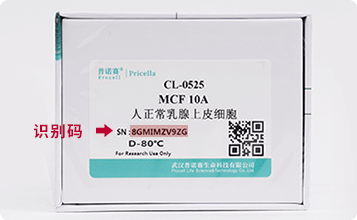货号: CL-0007
Price: ¥1600 ¥1600
生长培养基: RPMI-1640[PM150110]+10% FBS[164210]+1% P/S[PB180120]
产品信息
| 产品名称 | 4T1(小鼠乳腺癌细胞) |
| 别称 | 4T1-A |
| 生长特性 | 贴壁细胞 |
| 细胞形态 | 上皮细胞样 |
| 冻存条件 |
冻存液:55% 基础培养基+40% FBS+5% DMSO 温度:液氮 |
| 培养方案A(默认) |
生长培养基:RPMI-1640[PM150110]+10% FBS[164210]+1% P/S[PB180120] 培养条件: 气相:空气,95%;CO₂,5%, 温度:37℃ |
| 培养方案B(可选) |
生长培养基: 培养条件: 气相:, 温度:37℃ |
| 推荐传代比例 | 1:3-1:6 |
| 推荐换液频率 | 2-3次/周 |
参考资料(来源文献)
| 背景描述 | 4T1细胞是从410.4瘤株中未经诱变筛得的6-硫鸟嘌噙抗性细胞株。当4T1细胞注射到BALB/c小鼠中时,4T1细胞会自发产生高转移肿瘤,可转移到肺、肝、淋巴结和大脑,同时在注射部位形成始发灶,诱导转移时不需要摘除始发灶。4T1细胞在BALB/c小鼠中的生长与转移特性与人体中的乳腺癌十分相近,这种肿瘤是人Ⅵ期乳腺癌的动物模型。4T1细胞诱导的肿瘤在手术后及未手术情况下转移的动力学相近,可以用作手术后及未手术模型。4T1细胞诱导的肿瘤模型跟其他肿瘤模型相比,由于4T1细胞的抗6-硫鸟嘌噙特性,微小的转移细胞团(少到仅仅1个)也可以在许多远端器官中检测到,没必要数淋巴结或称重器官。 |
| 年龄(性别) | Female |
| 组织来源 | 乳腺组织 |
| 细胞类型 | 肿瘤细胞 |
| 肿瘤类型 | 乳腺癌细胞 |
| 生物安全等级 | BSL-1 |
| 致瘤性 | Yes, forms tumors and metastasizes in BALB/c mice. |
STR位点信息
STR鉴定图
-
Injectable, Biodegradable, Thermosensitive Nanoparticles-Aggregated Hydrogel with Tumor-Specific Targeting, Penetration, and Release for Efficient Postsurgical Prevention of Tumor Recurrence(2019)
作者:Huiming Liu, Xiaoguang Shi, Di Wu
期刊:ACS Applied Materials & Interfaces
影响因子:9.5
引用产品: 4T1 细胞
-
MSOT/CT/MR imaging-guided and hypoxia-maneuvered oxygen self-supply radiotherapy based on one-pot MnO2-mSiO2@Au nanoparticles(2019)
作者:Siyu Wang, Qing You, Jinping Wang
期刊:Nanoscale
影响因子:6.7
引用产品: 4T1 细胞
-
MSOT/CT/MR imaging-guided and hypoxia-maneuvered oxygen self-supply radiotherapy based on one-pot MnO2 -mSiO2 @ Au nanoparticle(2019)
作者:Siyu Wang , Qing You , Jinping Wang
期刊:Nanoscale
影响因子:6.7
引用产品: 4T1 细胞, DMEM高糖 培养基, 特级胎牛血清, 青霉素-链霉素溶液 (双抗),100×
-
NIRF/PA/CT multi-modality imaging guided combined photothermal and photodynamic therapy based on tumor microenvironment-responsive nanocomposites(2018)
作者:Li Liu, Jinping Wang, Qing You
期刊:Journal of Materials chemistry. B
影响因子:7.6
引用产品: 4T1 细胞
-
Magnetically-targeted and near infrared fluorescence/magnetic resonance/photoacoustic imaging-guided combinational anti-tumor phototherapy based on polydopamine-capped magnetic Prussian blue nanoparticles(2018)
作者:Yidan Wang, Xiaojuan Pang, Jinping Wang
期刊:Journal of Materials Chemistry B
影响因子:7.6
引用产品: 4T1 细胞
-
A tungsten nitride-based degradable nanoplatform for dual-modal image-guided combinatorial chemo-photothermal therapy of tumors(2018)
作者:Cheng Zhang,Shibo Wang,Zhaoxia Chen
期刊:Nanoscale
影响因子:6.7
引用产品: CT26.WT 细胞, 4T1 细胞
-
Oxygen-rich chemotherapy via modified Abraxane to inhibit the growth and metastasis of triple-negative breast cancer(2018)
作者:Lingtong Meng, Shaoju Gan, Ya Zhou
期刊:Biomaterials Science
影响因子:6.6
引用产品: 4T1 细胞
-
Xiaoyao Kangai Jieyu Fang, a Chinese Herbal Formulation, Ameliorates Cancer-Related Depression Concurrent with Breast Cancer in Mice via Promoting Hippocampal Synaptic Plasticity(2018)
作者:Pan Meng, Yuanshan Han, Qin Yang
期刊:Evidence-based Complementary and Alternative Medicine
影响因子:2.7
引用产品: 4T1 细胞
-
A photoresponsive and rod-shape nanocarrier: Single wavelength of light triggered photothermal and photodynamic therapy based on AuNRs-capped & Ce6-doped mesoporous silica nanorods(2017)
作者:Qi Sun, Qing You, Xiaojuan
期刊:Biomaterials
DOI:10.1016/j.biomaterials.2017.01.021
影响因子:14.0
引用产品: 4T1 细胞
-
Hollow Au–Cu Nanocomposite for Real-Time Tracing Photothermal/Antiangiogenic Therapy(2017)
作者:Xiaojuan Pang, Xiaoxiao Tan, Jinping Wang
期刊:Advanced Healthcare Materials
影响因子:10.0
引用产品: 4T1 细胞, PUMC-HUVEC-T1
-
Q1:为什么我看的文献里的细胞培养条件和你们官网的培养条件不一样呢?
部分细胞是会出现多种培养条件的,我们公司优先选择引种来源的培养条件以及建系者所用培养条件,出现差异的原因是不同实验室在保藏过程中更改了细胞的培养条件,为了避免细胞突然更换培养条件后不适应,建议您优先使用厂家推荐的培养条件培养。

识别码示意图





